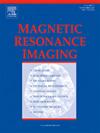深度学习重建在呼吸触发单次相敏反转恢复心肌延迟增强心脏磁共振降噪中的应用。
IF 2
4区 医学
Q2 RADIOLOGY, NUCLEAR MEDICINE & MEDICAL IMAGING
引用次数: 0
摘要
背景:相敏反转恢复晚期钆增强(LGE)可改善组织造像,但与自由呼吸采集相结合具有挑战性。深度学习(DL)算法在心脏磁共振成像(CMR)中得到越来越多的应用,以提高图像质量。我们将带有呼吸触发(FB-PS)序列的自由呼吸单次相敏LGE与DL降噪重建算法的新组合与在屏气期间获得的传统分段相敏LGE (BH-PS)进行了比较。方法:61例成人受试者(男性29例,51岁 ± 15)采用FB-PS序列和常规BH-PS序列行临床CMR(1.5 T)。DL降噪被纳入到图像重建管道中。定性指标包括图像质量、伪影严重程度、诊断可信度。定量指标包括血隔边界清晰度、LGE清晰度、血-心肌表观信噪比(CNR)、LGE-心肌表观信噪比(SNR)和LGE负荷。序列通过配对t检验进行比较。结果:27例LGE阳性。FB-PS获得切片的平均时间为4-12 s,而BH-PS获得切片的平均时间为~32-38 s(包括呼吸指示和屏气之间的休息时间)。中等DL降噪的FB-PS具有更好的图像质量(FB-PS 3.0 ± 0.7 vs BH-PS 1.5 ± 0.6,p )结论:FB-PS序列使扫描时间缩短了5倍以上,并减少了运动伪影。结合DL降噪算法,FB-PS提供比BH-PS更好或相似的图像质量。对于无法屏住呼吸的病人来说,这是一个很有希望的解决方案。本文章由计算机程序翻译,如有差异,请以英文原文为准。
Deep-learning reconstruction for noise reduction in respiratory-triggered single-shot phase sensitive inversion recovery myocardial delayed enhancement cardiac magnetic resonance
Background
Phase-sensitive inversion recovery late gadolinium enhancement (LGE) improves tissue contrast, however it is challenging to combine with a free-breathing acquisition. Deep-learning (DL) algorithms have growing applications in cardiac magnetic resonance imaging (CMR) to improve image quality. We compared a novel combination of a free-breathing single-shot phase-sensitive LGE with respiratory triggering (FB-PS) sequence with DL noise reduction reconstruction algorithm to a conventional segmented phase-sensitive LGE acquired during breath holding (BH-PS).
Methods
61 adult subjects (29 male, age 51 ± 15) underwent clinical CMR (1.5 T) with the FB-PS sequence and the conventional BH-PS sequence. DL noise reduction was incorporated into the image reconstruction pipeline. Qualitative metrics included image quality, artifact severity, diagnostic confidence. Quantitative metrics included septal-blood border sharpness, LGE sharpness, blood-myocardium apparent contrast-to-noise ratio (CNR), LGE-myocardium CNR, LGE apparent signal-to-noise ratio (SNR), and LGE burden. The sequences were compared via paired t-tests.
Results
27 subjects had positive LGE. Average time to acquire a slice for FB-PS was 4–12 s versus ∼32–38 s for BH-PS (including breath instructions and break time in between breath hold). FB-PS with medium DL noise reduction had better image quality (FB-PS 3.0 ± 0.7 vs. BH-PS 1.5 ± 0.6, p < 0.0001), less artifact (4.8 ± 0.5 vs. 3.4 ± 1.1, p < 0.0001), and higher diagnostic confidence (4.0 ± 0.6 vs. 2.6 ± 0.8, p < 0.0001). Septum sharpness in FB-PS with DL reconstruction versus BH-PS was not significantly different. There was no significant difference in LGE sharpness or LGE burden. FB-PS had superior blood-myocardium CNR (17.2 ± 6.9 vs. 16.4 ± 6.0, p = 0.040), LGE-myocardium CNR (12.1 ± 7.2 vs. 10.4 ± 6.6, p = 0.054), and LGE SNR (59.8 ± 26.8 vs. 31.2 ± 24.1, p < 0.001); these metrics further improved with DL noise reduction.
Conclusion
A FB-PS sequence shortens scan time by over 5-fold and reduces motion artifact. Combined with a DL noise reduction algorithm, FB-PS provides better or similar image quality compared to BH-PS. This is a promising solution for patients who cannot hold their breath.
求助全文
通过发布文献求助,成功后即可免费获取论文全文。
去求助
来源期刊

Magnetic resonance imaging
医学-核医学
CiteScore
4.70
自引率
4.00%
发文量
194
审稿时长
83 days
期刊介绍:
Magnetic Resonance Imaging (MRI) is the first international multidisciplinary journal encompassing physical, life, and clinical science investigations as they relate to the development and use of magnetic resonance imaging. MRI is dedicated to both basic research, technological innovation and applications, providing a single forum for communication among radiologists, physicists, chemists, biochemists, biologists, engineers, internists, pathologists, physiologists, computer scientists, and mathematicians.
 求助内容:
求助内容: 应助结果提醒方式:
应助结果提醒方式:


